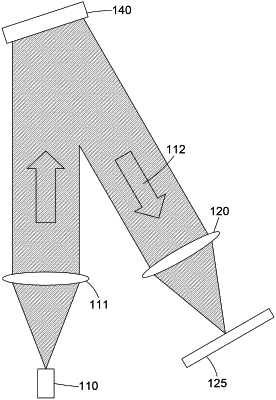| CPC G03H 1/2202 (2013.01) [G01S 7/4865 (2013.01); G01S 17/88 (2013.01); G03H 2001/2244 (2013.01)] | 22 Claims |

|
1. A light detection and ranging, “LiDAR”, system arranged to make time of flight measurements of a scene, the LiDAR system comprising:
a holographic projector comprising: a spatial light modulator arranged to display light modulation patterns, each light modulation pattern comprising a hologram and grating function having a periodicity; a light source arranged to illuminate each displayed light modulation pattern in turn; and a projection lens arranged to receive spatially modulated light from the spatial light modulator and project a structured light pattern corresponding to each hologram onto a respective replay plane, wherein the position of the structured light pattern on the replay plane is determined by the periodicity of the corresponding grating function;
wherein there is a spatial separation between the spatial light modulator and the array of detection elements, such that they have two different respective lines of sight of a target, within the scene;
a detector comprising an array of detection elements and an imaging lens arranged such that each detection element receives light from a respective sub-area of the holographic replay plane, wherein the sub-areas collectively define a field of view of the detector on the replay plane; and
a system controller arranged to receive distance information related to the scene and output to the holographic projector a control signal corresponding to the distance information, wherein the holographic projector is arranged to use the control signal to determine a parameter for projection of a subsequent structured light pattern;
wherein the parameter is indicative of a subsequent grating function that should be selected, for combination with a hologram, to ensure that the resulting structured light pattern, corresponding to that subsequent grating function, will be located within the detector's field of view on the replay plane.
|